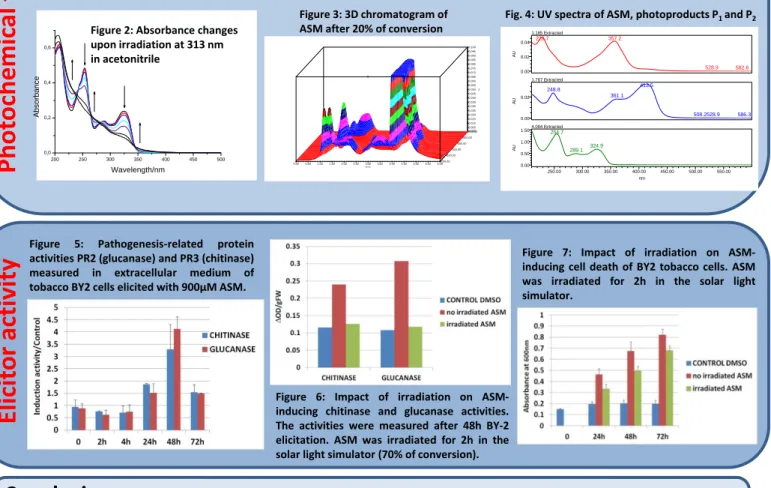HAL Id: hal-01268782
https://hal.archives-ouvertes.fr/hal-01268782
Submitted on 5 Jun 2020
HAL is a multi-disciplinary open access
archive for the deposit and dissemination of
sci-entific research documents, whether they are
pub-lished or not. The documents may come from
teaching and research institutions in France or
abroad, or from public or private research centers.
L’archive ouverte pluridisciplinaire HAL, est
destinée au dépôt et à la diffusion de documents
scientifiques de niveau recherche, publiés ou non,
émanant des établissements d’enseignement et de
recherche français ou étrangers, des laboratoires
publics ou privés.
Effect of solar light on the fate of elicitor
acibenzolar-S-methyl, during the use phase of its life
cycle
S. Wang, T. Charbouillot, Pascale Goupil, M. Saudreau, C. Richard
To cite this version:
S. Wang, T. Charbouillot, Pascale Goupil, M. Saudreau, C. Richard. Effect of solar light on the fate
of elicitor acibenzolar-S-methyl, during the use phase of its life cycle. Congrès Biocontrol2014, Sep
2014, Perpignan, France. 1 p. �hal-01268782�
Effect of solar light on the fate of elicitor acibenzolar‐S‐methyl, during the use phase of
its life cycle
S. Wang
1,3, T. Charbouillot
1,3, P. Goupil
2,4, M. Saudreau
2,4, C. Richard
1,3(1) Clermont Université, Université Blaise Pascal, Institut de Chimie de Clermont‐Ferrand, BP 10448, F‐63000 CLERMONT‐FERRAND, FRANCE (2) Clermont Université, Université Blaise Pascal, PIAF, BP 10448, F‐63000 CLERMONT‐FERRAND, FRANCE (3) CNRS, UMR 6296, ICCF, F‐63171 Aubière, FRANCE (4) INRA, UMR 547, PIAF, F‐63171 Aubière, France 1.185 Extracted 228.7 357.2 528.9 582.6 AU 0.00 0.02 0.04 1.767 Extracted 248.8 361.1 413.5 508.2528.9 586.3 AU 0.00 0.02 4.084 Extracted 254.7 289.1 324.9 AU 0.00 0.50 1.00 1.50 nm 250.00 300.00 350.00 400.00 450.00 500.00 550.00 0 100 200 300 400 500 0,0 5,0x10-6 1,0x10-5 1,5x10-5 2,0x10-5 2,5x10-5 [A S M ] Time/min
Phot
ochemic
al
tr
ans
forma
tion
Figure 1: ASM consumption upon irradiation in a solar light simulator on wax filmIntroduction
The light distribution within a plant canopy governs the lifetime of the active ingredient of phytosanitary products and the formation of degradates on the leaves. Their early dissipation makes necessary the repetition of applications and thus leads to a chemical crop input increase. Our work aims to analyse the links between the canopy architecture, the microclimate and the active ingredient photodegradation focusing on the biological effects on plants through the study of induced natural defense systems (SDN). The work presented here focuses on the first step of the project : to determine the photodegradability of selected active ingredients upon irradiation with solar light and monitore the elicitor activity of the active ingredient and photoproducts on cell culture system.The chosen active ingredient is Acybenzolar‐S‐Methyl (ASM). This analog of salicylic acid has no direct effect on the pathogen but exerts a stimulation on the plant defense system. It is marketed in France as Bion. ASM absorbs solar light intensively below 350 nm; therefore it can potentially undergo photolysis.
Figure 1 shows that ASM undergoes fast photolysis when it is deposited on wax films that mimic the
epicuticular layer of leaves and exposed to simulated solar light (400 W/m2within the range 290‐800 nm).
Under these conditions, its half‐life is only one hour. In a good agreement, the photolysis quantum yields in organic solution are comprised between 0.067 and 0.092, confirming the good efficiency of the photolytic process and thus the photolabile character of ASM.
Figure 2 gives the spectral evolution of an ASM solution in acetonitrile upon irradiation. The characteristic bands of ASM at 250 and 320 nm disappear while news bands around 225, 270 and 350 appear.
The main photoproducts P1 and P2formed on wax films in beginning of the irradiation are shown on the
2D chromatogram (Figure 3). Their absorption spectra are given in Figure 4
.
Figure 3: 3D chromatogram of ASM after 20% of conversion Fig. 4: UV spectra of ASM, photoproducts P1 and P2 0.000 0.005 0.010 0.015 0.020 0.025 0.030 0.035 0.040 0.045 0.050 0.055 0.060 0.065 0.070 0.075 0.080 0.085 0.090 0.095 0.100 AU 0.00 0.50 1.00 1.50 2.00 2.50 3.00 3.50 4.00 4.50 5.00 5.50 6.00 Minutes 200.00 250.00 300.00 350.00 400.00 450.00Figure 5: Pathogenesis‐related protein
activities PR2 (glucanase) and PR3 (chitinase)
measured in extracellular medium of
tobacco BY2 cells elicited with 900µM ASM.
Figure 6: Impact of irradiation on ASM‐ inducing chitinase and glucanase activities. The activities were measured after 48h BY‐2 elicitation. ASM was irradiated for 2h in the solar light simulator (70% of conversion).
Figure 7: Impact of irradiation on ASM‐ inducing cell death of BY2 tobacco cells. ASM was irradiated for 2h in the solar light simulator.
